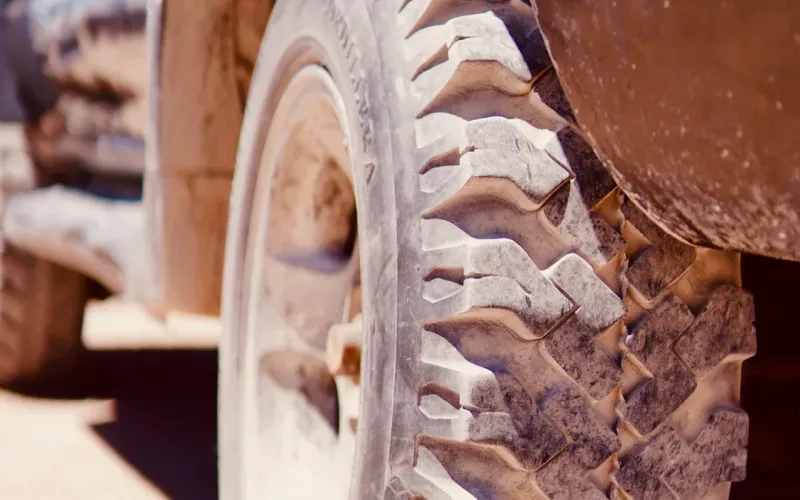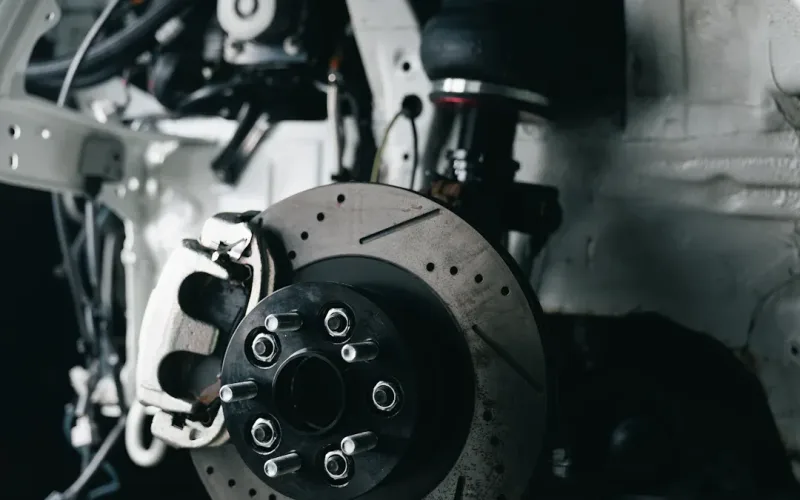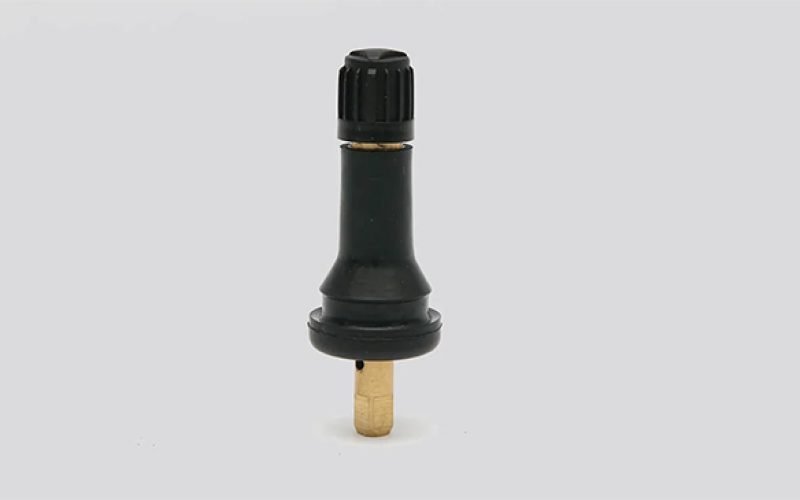

admin1
June 26, 2025
Understanding Balance Weight on Tire for a Smoother Ride
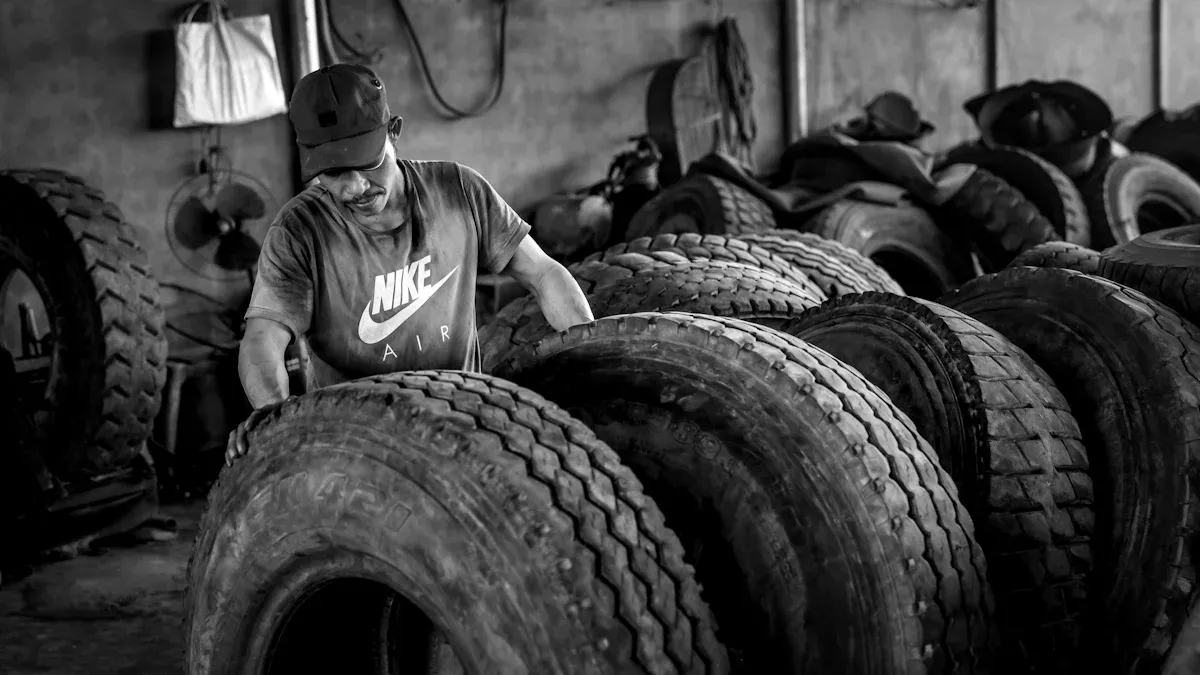
When you drive, even a small imbalance in your wheel can cause big problems. A balance weight on tire attaches to your wheel and helps keep your tire rolling smoothly. Wheel weights correct uneven weight in the wheel, which reduces vibrations. If your wheels are not balanced, you may feel shaking or lose control. In the US, tire bursts have led to hundreds of deaths and thousands of injuries each year. Using the right wheel weights gives you a smooth and balanced ride and helps protect your safety.
What Is a Balance Weight on Tire and How Does It Work?

Definition and Purpose of Balance Weight on Tire
A balance weight on tire is a small device that attaches to your wheel. You use it to fix uneven weight around the tire and wheel assembly. When you drive, even a tiny difference in weight can cause your wheel to spin unevenly. This leads to vibrations and makes your ride less comfortable. You need balance weights to keep your wheels turning smoothly. These weights help you avoid shaking, noise, and extra wear on your tires. Manufacturers check for both static and dynamic imbalances during tire production and after mounting. If they find too much imbalance, they add balance weights to correct it. This process keeps your vehicle stable, especially at high speeds. Some companies also use colored marks on the tire sidewall to help match the tire and wheel for better balance. You can find other methods, like internal balancing agents, but most vehicles rely on balance weights for the best results.
How Wheel Weights Ensure Proper Tire Balance
Wheel weights play a key role in keeping your tires properly balanced. When you mount a tire on a wheel, you may notice that the weight is not spread out evenly. This can happen because of small differences in the tire or wheel. Wheel weights fix this by adding mass to certain spots on the rim. You start by measuring the rim and wheel size. Then, you use a balancing machine to spin the wheel and find where the imbalance is. The machine tells you exactly how much weight to add and where to put it. You attach the weights at those points, usually on the inner or outer rim. After you add the weights, you spin the wheel again to check if it is balanced. This careful process makes sure your wheels have minimal vibration. Balanced wheels give you a smoother ride, better handling, and longer tire life. Industry reports show that balanced wheels also help your suspension last longer and improve fuel efficiency. When you use wheel weights, you keep your vehicle safe and comfortable.
Tip: Always check your tire balance after installing new tires or if you notice vibrations while driving. Properly balanced rims help you avoid costly repairs and keep your ride smooth.
Types of Wheel Weights: Clip-On, Adhesive, and More
You have several wheel weight options to choose from. The most common types are clip-on and adhesive wheel weights. Clip-on weights snap onto the edge of steel wheels. They are quick to install and stay secure, even in tough driving conditions. Adhesive weights, also called stick-on weights, use a strong glue to attach to the inside of alloy wheels. These weights are great for custom or stylized wheels because they are less visible and do not damage the wheel finish. Both types come in different materials, such as steel, zinc, and lead. Steel is popular because it resists fatigue and handles stress well. Zinc is more eco-friendly and also durable. Lead was common in the past, but many places now limit its use for environmental reasons.
Here is a table to help you compare the main types of wheel weights:
| Feature/Aspect | Clip-On Wheel Weights | Adhesive (Stick-On) Wheel Weights |
|---|---|---|
| Installation | Clips onto rim edge; quick and tool-free | Adheres with strong adhesive; requires surface prep |
| Suitable Wheel Type | Steel wheels or rims with pronounced lip/flange | Alloy wheels or rims without a lip |
| Durability | High durability; secure in harsh driving conditions | Dependent on adhesive quality and surface cleanliness |
| Aesthetics | Visible on rim edge | Cleaner, more discreet appearance |
| Balancing Precision | Accurate when properly installed | Allows precise placement for exact balancing |
| Material Options | Typically steel, zinc, or lead (with environmental limits) | Similar materials; adhesive backing adds flexibility |
| Environmental Impact | Lead restricted; zinc more sustainable | Same considerations apply |
| Additional Notes | Best for traditional wheels; may not fit all types | Preferred for stylized/custom wheels; surface prep critical |
You should pick the type that matches your wheel and driving needs. Clip-on and adhesive wheel weights both offer reliable solutions for keeping your tires balanced. When you choose the right wheel weight materials, you help your tires last longer and your vehicle perform better.
Causes and Effects of Tire Imbalance
Common Reasons for Tire Imbalance
You may notice your car does not drive as smoothly as before. This often happens when your tire and wheel do not have equal weight all around. Several things can cause this problem:
- Uneven tire wear: If your tire wears down more on one side, the weight changes.
- Bent or damaged wheels: Hitting a curb or pothole can bend your wheel and cause imbalance.
- Incorrect wheel alignment: When your wheel alignment is off, your tires do not point in the right direction. This can lead to uneven weight and faster tire wear.
- Poor installation: If a tire is not mounted correctly on the wheel, it may not spin evenly.
- Loss of wheel weights: Sometimes, a wheel weight falls off, which leads to poor balance.
You should check your wheel alignment and tire condition regularly. This helps you catch problems early.
Symptoms of Poor Tire Balance
You can spot signs of tire imbalance while driving. Look for these symptoms:
- Vibration in the steering wheel, seat, or floor, especially at higher speeds.
- Uneven or rapid tire wear.
- Noisy ride or humming sounds from the tires.
- Your car pulls to one side, even when the road is flat.
- The steering wheel feels shaky or hard to control.
Tip: If you feel any of these symptoms, schedule a wheel alignment and balance check soon. Early action can prevent bigger issues.
Risks of Ignoring Tire Imbalance
Ignoring tire imbalance can lead to serious problems. You may face:
- Shorter tire life: Uneven wear means you need new tires sooner.
- Damage to suspension and steering parts: Vibrations put extra stress on these systems.
- Poor fuel efficiency: Your car works harder to move, so you use more gas.
- Unsafe driving: Loss of control, especially at high speeds, increases accident risk.
- More frequent wheel alignment issues: Imbalance can make your wheel alignment worse over time.
A balanced tire and proper wheel alignment keep your ride safe and smooth. You protect your investment and avoid costly repairs when you address these issues quickly.
The Tire Balance Process and Wheel Weights Application

How Professionals Achieve Tire Balance
When you visit a shop for tire balancing, trained technicians follow a careful process. First, they mount your wheel on a balancing machine using special clamps. This step ensures the wheel sits perfectly centered. The machine spins the wheel at a set speed. Sensors inside the machine measure how the weight spreads around the tire and wheel. The machine then shows where to place wheel weights to fix any imbalance. Technicians use adhesive or clip-on wheel weights, depending on your wheel type. They attach the weights at the exact spots the machine recommends. After adding the weights, they spin the wheel again to check if it will rotate without vibration. If needed, they adjust the weights for perfect tire balance. Advanced machines, like the Hofmann geodyna 8200, use lasers and smart sensors for even more precise wheel weights placement. Shops also train their staff to follow safety steps and keep equipment in top shape.
Tip: Always make sure your technician uses clean wheels and removes old weights before balancing tire assemblies.
Static vs. Dynamic Tire Balancing Methods
You may hear about static and dynamic tire balancing. Both methods use wheel weights, but they solve different problems. Here is a table to help you compare:
| Aspect | Static Balancing | Dynamic Balancing |
|---|---|---|
| What it fixes | Up-and-down (vertical) vibration | Side-to-side (shimmy) vibration |
| How it works | Adds weights to balance the wheel’s center line | Adds weights to both sides of the wheel |
| Best for | Simple, narrow wheels | Modern, wider wheels |
| Equipment used | Basic balancer | Advanced balancer with sensors |
| Result | Reduces bounce | Reduces shimmy and uneven wear |
Dynamic tire balancing is the most common today. It uses wheel weights on both sides of the wheel to fix more complex imbalances. Static balancing works for older or narrow wheels. Both methods help your wheels rotate smoothly and improve wheel alignment.
When and How Often to Check Tire Balance
You should check tire balance at regular intervals. Most manufacturers suggest balancing tires every 5,000 to 7,500 miles. You also need tire balancing when you rotate your tires or notice vibrations, uneven wear, or changes in fuel use. Always check tire balance after installing new tires or wheel weights. If you feel shaking or see uneven tread, schedule a professional wheel balancing service. Technicians use special tools to inspect your wheel alignment and apply the right weights. Keeping up with tire balancing helps your wheels and tires last longer and keeps your ride safe.
- Inspect your tires for uneven wear.
- Feel for vibrations while driving.
- Ask a professional to check your wheels if you notice problems.
Regular tire balancing and correct wheel weights placement ensure your wheels rotate without vibration and keep your wheel alignment in top condition.
Benefits of Proper Tire Balance for Ride Quality and Safety
Enhanced Comfort and Smoother Ride
You notice the difference right away when your tires are balanced. The steering wheel feels steady, and the ride becomes much quieter. Studies on ride comfort show that balanced wheels reduce whole-body vibration, which means you feel less shaking in your seat and hands. Experts use standards like ISO 2631-1 and VDI 2057 to measure how much vibration reaches you. When your tires spin evenly, you enjoy a smooth and balanced ride, even on rough roads. Advanced suspension systems and electronic stability control also work better when your wheels are balanced. Many drivers report less noise and fewer bumps after a professional tire balance. Customer testimonials often mention how much more comfortable their daily drive becomes.
- Customer feedback highlights reduced vibrations and better handling.
- Case studies show improved ride comfort and less driver fatigue.
- Professional installers use precise equipment to make sure your tires are balanced for the best comfort.
Improved Safety and Vehicle Control
Proper tire balance plays a big role in keeping you safe. When your wheels are balanced, your car responds better to steering and braking. This helps you stay in control, especially during sudden moves or on slippery roads. Electronic Stability Control (ESC) systems rely on balanced tires to work at their best. Data from the National Highway Traffic Safety Administration (NHTSA) and other studies show that stability control systems can lower crash risks by a large margin.
| Crash Type | Vehicle Type | Reduction Percentage (95% CI) | Source/Study |
|---|---|---|---|
| Single-vehicle crashes | Passenger cars | 35% (29% – 41%) | Dang (2004), NHTSA |
| Single-vehicle crashes | SUVs | 67% (60% – 74%) | Dang (2004), NHTSA |
| Fatal single-vehicle crashes | Passenger cars | 30% (10% – 50%) | NHTSA (FARS data) |
| Fatal single-vehicle crashes | SUVs | 63% (44% – 81%) | NHTSA (FARS data) |
| Overall crash involvement | Stability control | 7% (3% – 10%) | Farmer (2004), IIHS |
| Single-vehicle crash risk | Stability control | 41% (33% – 48%) | Farmer (2004), IIHS |
| Overall fatal crash risk | Stability control | 34% (21% – 45%) | Farmer (2004), IIHS |
| Single-vehicle crashes | Toyota vehicles | 35% | Aga and Okada (2003), Japanese data |
| Vehicle-to-vehicle frontal impacts | Toyota vehicles | 30% | Aga and Okada (2003), Japanese data |
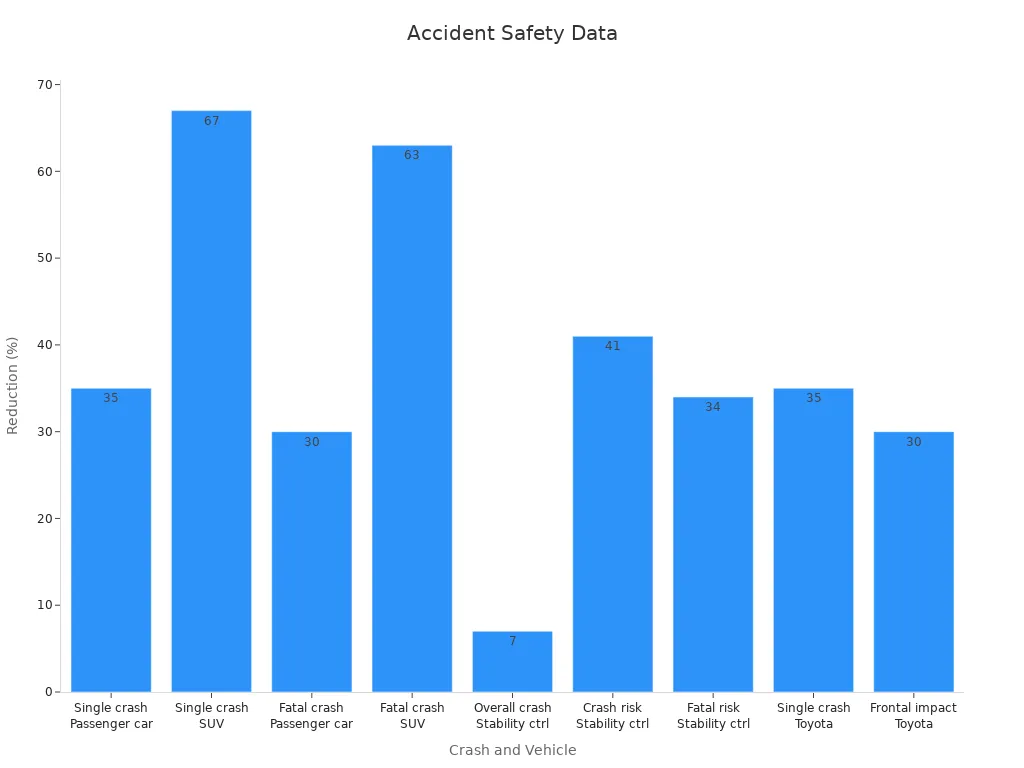
You can see from these numbers that balanced tires and advanced safety systems work together to improve vehicle stability and reduce accidents. Features like tactile sensors and LIDAR also help by giving real-time feedback about tire and road conditions, further improving vehicle performance.
Longer Tire Life and Cost Savings
When your tires are balanced, they wear down evenly. This means you do not have to replace them as often. Balanced wheels also protect your suspension and steering parts from extra stress. Case studies show that proper tire balance leads to longer tire life and better fuel efficiency. You save money on repairs and gas over time. Many customers return to shops that offer professional tire balancing because they trust the results. Shops use advanced machines to make sure each wheel gets the right weight, which keeps your tires rolling smoothly and helps you avoid costly problems.
Tip: Regular tire balancing is a smart way to protect your investment and keep your car running safely.
Practical Tips for Maintaining Tire Balance
How to Detect Balance Issues Early
You can spot balance problems before they become serious. Watch for signs like vibrations in your steering wheel or seat. Uneven tire wear often points to poor balance. Listen for unusual noises while driving. If your car pulls to one side or you notice poor fuel economy, check your tires and wheel weights. Regular inspections help you catch these issues early. Experts recommend checking your tire pressure every month and before long trips. Keep an eye on your wheel weights to make sure none have fallen off. If you see a missing weight, get it replaced right away. Early detection keeps your ride smooth and safe.
DIY Tire Balance vs. Professional Service
You might wonder if you can balance your tires at home. DIY kits let you try, but most people do not have the right tools. Professional shops use advanced machines to measure where to place wheel weights. They follow a careful process: lift your car, remove the wheels, inspect the tires, spin them on a balancer, attach the weights, and check again. Shops use both static and dynamic balancing methods. Dynamic balancing uses wheel weights on both sides of the rim for better results. Professionals also use proper torque when reinstalling your wheels. This ensures your wheel weights stay in place and your tires stay balanced. You get better comfort, longer tire life, and improved fuel efficiency with expert service.
Note: Regular tire rotation every 5,000 to 8,000 miles helps your wheel weights work better and keeps your tires wearing evenly.
When to Seek Expert Help for Tire Balance
Some problems need a professional right away. If you feel strong vibrations, see uneven tire wear, or notice your car pulling to one side, visit a shop. Steering wheel vibrations during braking often mean your wheel weights need adjustment. Case studies show that ignoring these signs leads to higher costs and safety risks. Many drivers report better comfort and longer tire life after getting professional help. Fleet managers save money and improve performance by checking wheel weights and alignment often. Real-life stories show that expert balancing and the right weights prevent accidents and costly repairs. Trust a trained technician to inspect your tires, check your wheel weights, and keep your vehicle safe.
You keep your ride smooth and safe when you use balance weights on your tires. Regular tire balance checks help you avoid vibrations and protect your car. Quality wheel weights, like those from Fortune, give you better control and longer tire life.
Remember: Balanced tires mean safer trips for you and your family.
Action Steps:
- Inspect your tires for signs of imbalance.
- Schedule regular balance checks.
- Choose trusted professionals and reliable products for your tire care.
FAQ
What happens if you drive with unbalanced tires?
You may feel vibrations in your steering wheel or seat. Unbalanced tires can cause uneven tire wear and reduce your car’s safety. You might also notice poor fuel efficiency. Fixing the balance helps you avoid these problems.
How often should you balance your tires?
You should balance your tires every 5,000 to 7,500 miles. Always check the balance after installing new tires or if you notice vibrations. Regular balancing keeps your ride smooth and extends tire life.
Can you reuse wheel weights after removing them?
You should not reuse wheel weights. Once removed, they may not attach securely again. New weights ensure proper fit and balance. Using fresh wheel weights helps you maintain safety and performance.
What are the signs that your wheel weights have fallen off?
Look for these signs:
- Sudden vibrations while driving
- Uneven tire wear
- Noises from your wheels
Tip: If you notice any of these, visit a professional for a balance check right away.
